Mushkin XP2 PC2-5300 DDR2 – Xtreme Performance Memory
by Steve Carmel & Wesley Fink on March 28, 2006 12:01 AM EST- Posted in
- Memory
Mushkin XP2 PC2-5300 DDR2: Stock Memory Performance
The Intel platform does not really allow for easily testing different memory speeds at the same CPU speed. Instead, most top motherboards provide a wide range of memory ratios that match available DDR2 memory. Therefore, we first tested all of the stock ratios at the fastest stable timings that we could achieve at the given ratio.
The Mushkin DDR2 5300 would not operate at DDR2 1066, so the highest stock ratio supported was DDR2 800. We then overclocked the DDR2 800 ratio (2:3) to the highest memory speed that we could support with stability. This turned out to be 1021 DDR2.
There are other possible approaches to overclocking DDR2 memory on the Intel platform. Probably the most logical, given that the memory controller resides on the Intel chipset rather than the processor, is to look at overclocking at a 1:1 ratio. For our test setup, that means a DDR2 533 base setting. You can see results of that approach on pages 10-12.
To put memory performance in perspective, screenshots of default memory performance provide a baseline for performance in SiSoft Sandra Professional 2005, Everest Ultimate Edition 2006, and memory scores at default settings from Futuremark's PCMark05.
Below is a screen capture showing the default SPD timings. Note the SPD memory timings are as listed previously in the Elpida datasheet, at 5-5-5-12. Mushkin rates the memory at 3-3-3 timings, but you will have to set these tighter timings manually in BIOS.
The next two images are the default screen captures from SiSoft Sandra Professional 2005, both buffered and unbuffered renditions of performance at default settings in BIOS.
Here is how performance was depicted through the Everest Ultimate 2006 Edition benchmarks.
Finally, for comparative purposes later in this review, here are the results on the PCMark05 memory suite of tests.
The Intel platform does not really allow for easily testing different memory speeds at the same CPU speed. Instead, most top motherboards provide a wide range of memory ratios that match available DDR2 memory. Therefore, we first tested all of the stock ratios at the fastest stable timings that we could achieve at the given ratio.
| Mushkin XP2 PC2-5300 (Stock Memory Ratios) - 2x1GB Double-Bank | |||||||
| CPU Ratio at 3.47 GHz |
Memory Speed |
Best Memory Timings (Voltage) | Far Cry fps | Sandra Unbuffered | Sandra Standard Buffered | Super PI Mod 1.4 2M places (time in sec) | Half Life 2 Lost Coast fps |
| (4:3) | 400 DDR2 | 3-3-2-6 1T 2.1V |
60.68 | INT 2777 FLT 2810 |
INT 5500 FLT 5520 |
87.8 | 71.8 |
| (1:1) | 533 DDR2 | 3-3-3-10 1T 2.1V |
62.07 | INT 3402 FLT 3417 |
INT 6448 FLT 6451 |
85.7 | 73.2 |
| (4:5) | 667 DDR2 | 3-3-3-10 1T 2.1V |
62.86 | INT 3976 FLT 4010 |
INT 6562 FLT 6496 |
84.8 | 75.2 |
| (2:3) | 800 DDR2 | 4-4-4-12 1T 2.2V |
62.57 | INT 4134 FLT 4135 |
INT 6705 FLT 6710 |
84.5 | 76.9 |
| Highest Mem Speed (2:3) (Overclocked) |
1021 DDR2 | 5-5-5-15 1T 2.3V |
71.85 | INT 4933 FLT 4999 |
INT 8424 FLT 8448 |
71.7 | 84.9 |
The Mushkin DDR2 5300 would not operate at DDR2 1066, so the highest stock ratio supported was DDR2 800. We then overclocked the DDR2 800 ratio (2:3) to the highest memory speed that we could support with stability. This turned out to be 1021 DDR2.
There are other possible approaches to overclocking DDR2 memory on the Intel platform. Probably the most logical, given that the memory controller resides on the Intel chipset rather than the processor, is to look at overclocking at a 1:1 ratio. For our test setup, that means a DDR2 533 base setting. You can see results of that approach on pages 10-12.
To put memory performance in perspective, screenshots of default memory performance provide a baseline for performance in SiSoft Sandra Professional 2005, Everest Ultimate Edition 2006, and memory scores at default settings from Futuremark's PCMark05.
Below is a screen capture showing the default SPD timings. Note the SPD memory timings are as listed previously in the Elpida datasheet, at 5-5-5-12. Mushkin rates the memory at 3-3-3 timings, but you will have to set these tighter timings manually in BIOS.
The next two images are the default screen captures from SiSoft Sandra Professional 2005, both buffered and unbuffered renditions of performance at default settings in BIOS.
Here is how performance was depicted through the Everest Ultimate 2006 Edition benchmarks.



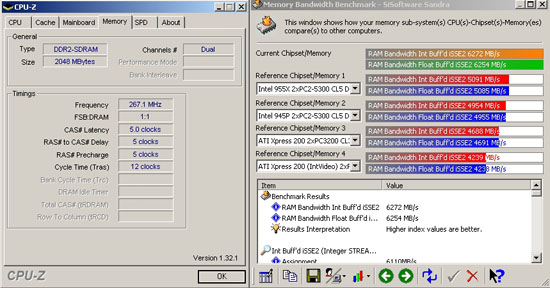
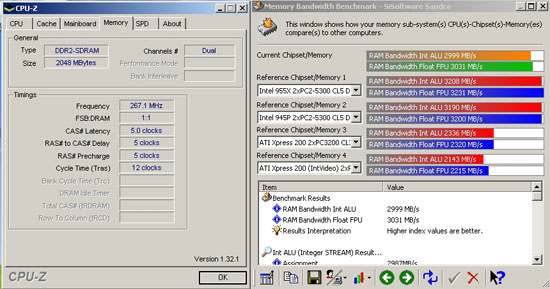
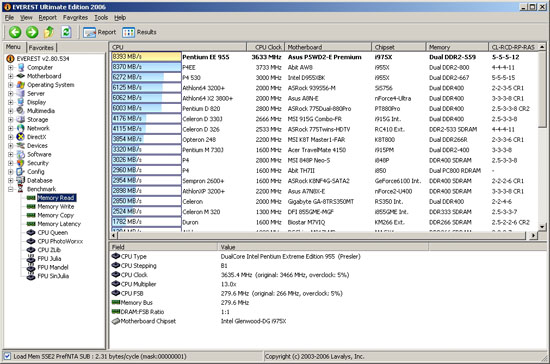
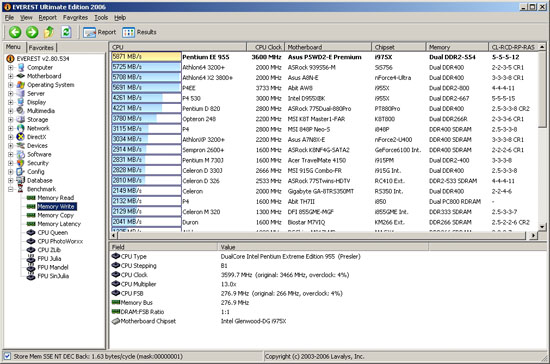
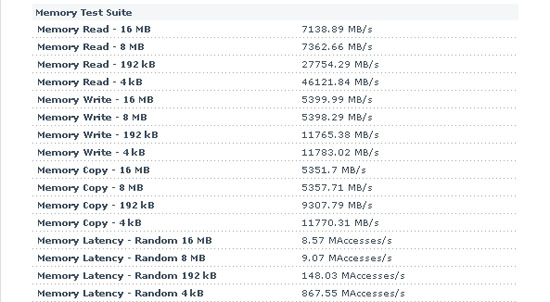








11 Comments
View All Comments
PrinceGaz - Tuesday, March 28, 2006 - link
"I know that the built in spreaders are fantastic for heat dissapation"There is a lot of debate over whether heatspreaders made any difference at all even with the hotter running DDR modules at 2.5V+. Many people believe the heatspreaders are more to do with making them look good rather than perform better. I really don't know either way as all the heatspreaders on my DDR modules seem to do is give a larger flat surface area for the heat to be dissipated from after the heat has been conducted from the individual chips (the heatspreaders even with overvolted modules don't feel particularly warm), and I'm unconvinced if
(a) there is any significant surface area in contact between the chips and heatspreader, let alone whether any thermal compound was used
(b) that might mean you would get better heat dissipation *without* a heatspreader as the cool air would be blowing directly over the memory chips themselves instead of having a heatspreader in the way
Given that DDR modules at normal voltages (up to 3V anyway, I'm not talking about the OCZ modules that could take 3.5V or so -- more than old SDRAM even) without getting very warm, why would cooler running DDR2 need heatspreaders unless pushed up from 1.8V to at least 2.3V. Memory chips don't give off much heat even when over-volted so heat-spreaders seem unnecessary, especially on DDR2 modules. Once you combine that with the fact that at least half the surface area of a memory module without a heatspreader is taken up by the memory chips anyway, there doesn't really seem much point in adding something to "spread" the heat over what is only a slightly larger area.
I will concede that heatspreaders look good though, and the minimal cost of them is returned many times in every premium module they sell with them.